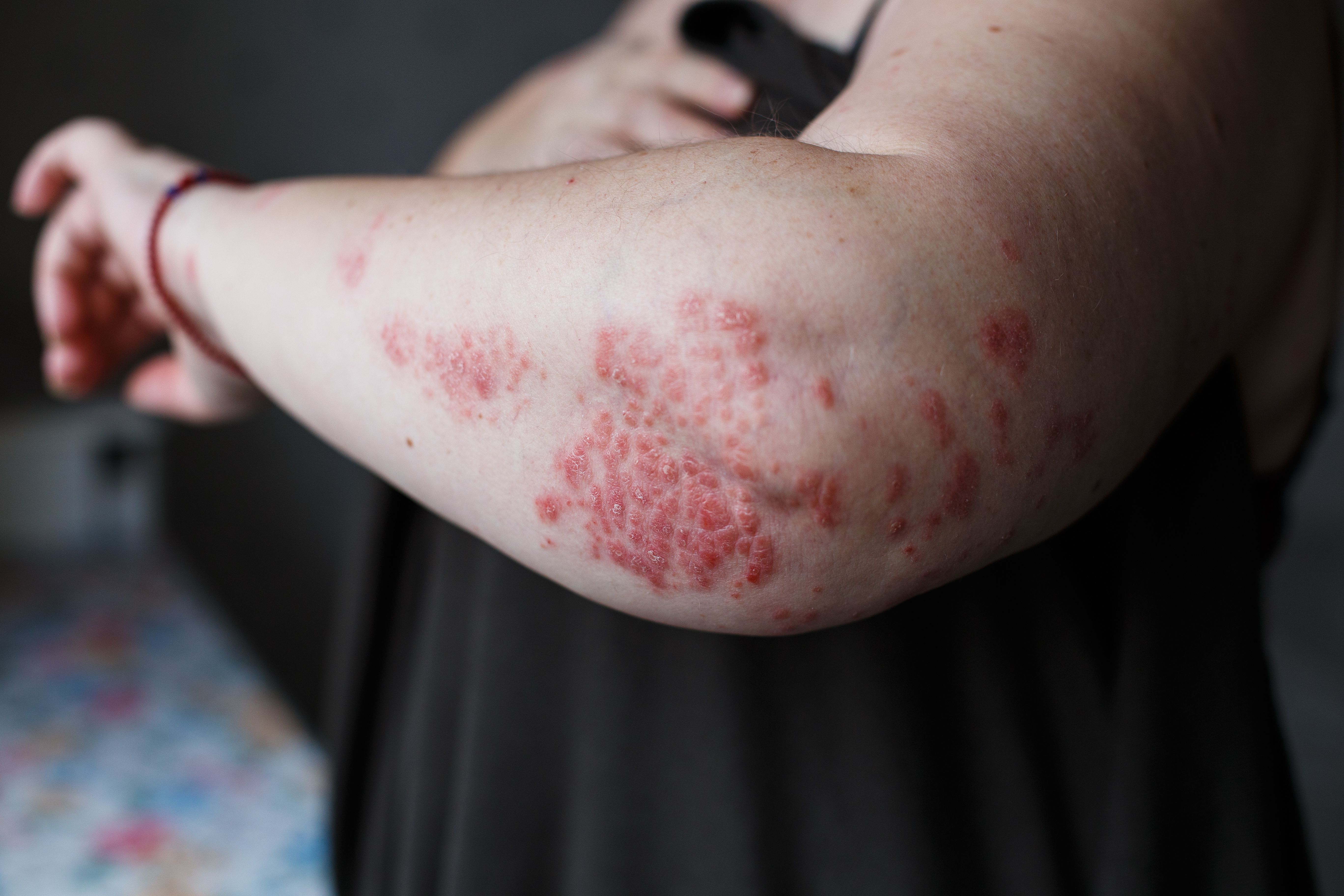- Case-Based Roundtable
- General Dermatology
- Eczema
- Chronic Hand Eczema
- Alopecia
- Aesthetics
- Vitiligo
- COVID-19
- Actinic Keratosis
- Precision Medicine and Biologics
- Rare Disease
- Wound Care
- Rosacea
- Psoriasis
- Psoriatic Arthritis
- Atopic Dermatitis
- Melasma
- NP and PA
- Skin Cancer
- Hidradenitis Suppurativa
- Drug Watch
- Pigmentary Disorders
- Acne
- Pediatric Dermatology
- Practice Management
- Prurigo Nodularis
- Buy-and-Bill
Publication
Article
Dermatology Times
Palmoplantar pustulosis rare, linked to psoriasis
Author(s):
Researchers recently undertook an epidemiologic study to investigate the prevalence of palmoplantar pustulosis (PPP) and co-existing plaque psoriasis. Read what they discovered in this article.
(Ольга Тернавская - stock.adobe.com)

Researchers recently undertook an epidemiologic study to investigate the prevalence of palmoplantar pustulosis (PPP) and co-existing plaque psoriasis.1
Palmoplantar pustulosis is characterized by recurrent sterile pustular dermatosis and erythematous plaques on the palms of the hands and soles of the feet, and often occurs alongside plaque psoriasis.2 As a result, some dermatologists actually consider the condition to be a subtype of psoriasis. This is still debated, however, due to evidence pointing towards differences between the genetic characteristics of PPP and those of plaque psoriasis.1,2,3
Although some research has connected PPP to tobacco use, cardiometabolic disease and/or autoimmune disease,4 little is known about the prevalence of palmoplantar pustulosis or the patients who suffer from the condition. The authors of the study, published in the British Journal of Dermatology in February 2019, aimed to fill this gap in research by collecting data from administrative healthcare registries and databases across the United States, Denmark and Germany.
THE STUDY
Researchers pulled data for the U.S. cohort from the Truven Health MarketScan database; the Danish Nationwide Registries for the Danish cohort; and the nationwide data set from Statutory Health insurance for the German cohort. The authors gathered information on the sex and age of participants, which were similar across the three groups. They also used the Carlson Comorbidity Index to estimate a weighted comorbidity score between 0 and 6. Psoriatic arthritis, hypertension, diabetes, thyroid disease and inflammatory bowel disease were also identified using ICD-10 coding.
Of the total 1,435,751 patients identified through the U.S., Danish and German databases, investigators found 1,832 patients had palmoplantar pustulosis. The one-year prevalence of palmoplantar pustulosis was estimated at 0.009% in the U.S. cohort; 0.005% in the Danish cohort; and 0.08% in the German cohort. In patients with palmar-plantar pustulosis, 61.3% had co-occurring psoriasis in the U.S. cohort; 14.2% had co-occurring psoriasis in the Danish cohort; and 36.4% had co-occurring psoriasis in the German cohort.
PREVALENCE, CO-OCCURANCE WITH PSORIASIS
The differences in prevalence of PPP and its co-occurrence with plaque psoriasis across the three cohorts might be due to a variety of factors, according to the study authors.
“While PPP typically presents with pustules on neutral colored skin, it may resemble psoriasis as erythematous and hyperkeratotic plaques may occur,” say the study investigators, led by Alexander Egeberg, M.D. Ph.D., department of dermatology and allergy, Copenhagen University Hospital Gentofte, Gentofte, Denmark. “Diagnostic challenges may therefore have caused some misclassifications of the disease.”
The authors also suggest that there may be nuances in the way physicians identify and diagnose PPP across the three countries, which could explain the differences in PPP prevalence (0.005 – 0.08%). Other types of psoriasis, such as guttate psoriasis and/or nail psoriasis, were also not included in the study, which could have affected the reported disease prevalence.
Additionally, the authors note, some cases of PPP may have been recorded as psoriasis, inflating the prevalence estimate in the U.S. cohort as there is no ICD-9 code for PPP in the U.S. and ICD-10 codes were not available until October 2015.
COMORBIDITIES
Investigators found that individuals with PPP and plaque psoriasis were also more likely to experience psoriatic arthritis in the U.S., Danish and German cohorts (21.8%, 25.2%, and 20.4% respectively) than patients with PPP who did not have psoriasis. Occurrence of comorbid conditions such as hypertension, diabetes, thyroid disease and IBD, however, appeared to be the same in individuals with PPP and psoriasis, and those without psoriasis, across the three cohorts.
It is well-known that psoriasis carries with it the risk of developing comorbidities such as cardiometabolic and immune-mediated inflammatory diseases due to systemic low-grade inflammation, genetic, lifestyle and environmental factors, but it remains unclear if PPP shares the same pathogenetic mechanisms.
“One possibly important link between PPP and cardiometabolic diseases may be cigarette smoking,” the authors report. “Indeed nicotine is thought to play a role in the pathogenesis and exacerbation of PPP and is a risk factor for cardiometabolic diseases.”
TREATMENT TRENDS
Topical steroids were most commonly prescribed to treat patients in all three cohorts; while the use of systemic therapies differed. Biologic used was most common in the U.S., but acitretin and methotrexate were most commonly used in Denmark. Cyclosporine use was comparable in all three countries.
“…discrepancies in the use of therapies may be explained by differences in local therapeutic guidelines and traditions among clinicians,” the study authors add.
TAKEAWAYS
Ultimately, study authors confirmed that palmoplantar pustulosis is not a very common condition (prevalence rate <0.1%) and that individuals with PPP also tend to suffer from plaque psoriasis; however, patients also seem to have an increased risk of developing psoriatic arthritis, though the reason why remains unclear.
More research is needed to better characterize the pathophysiology of palmoplantar pustulosis and its relationship with psoriasis.
References:
1. Andersen, YUKI MF, et al. "Characteristics and prevalence of plaque psoriasis in patients with palmoplantar pustulosis." British Journal of Dermatology. (2019).
2. Olazagasti JM, Ma JE, Wetter DA. Clinical features, etiological factors, associated disorders , and treatment of palmoplantar pustulosis: the May Clinic experience, 1996-2013. Mayo Clin Proc. 2017;92:13151-8.
3. Asumalahti K, Ameen M, Suomela S et al. Genetic analysis of PSORS1 distinguishes guttate psoriasis and palmoplantar pustulosis. J Invest Dermatol. 2003;120:627-32.
4. Becher G, Jamieson L, Leman J. Palmoplantar pustulosis – a retrospective review of comorbid conditions. J Eur Acad Dermatol Venereol. 201;29:1854-6,






